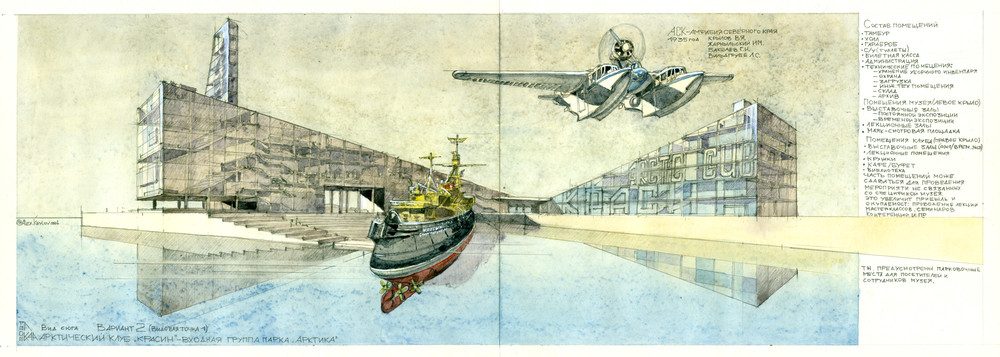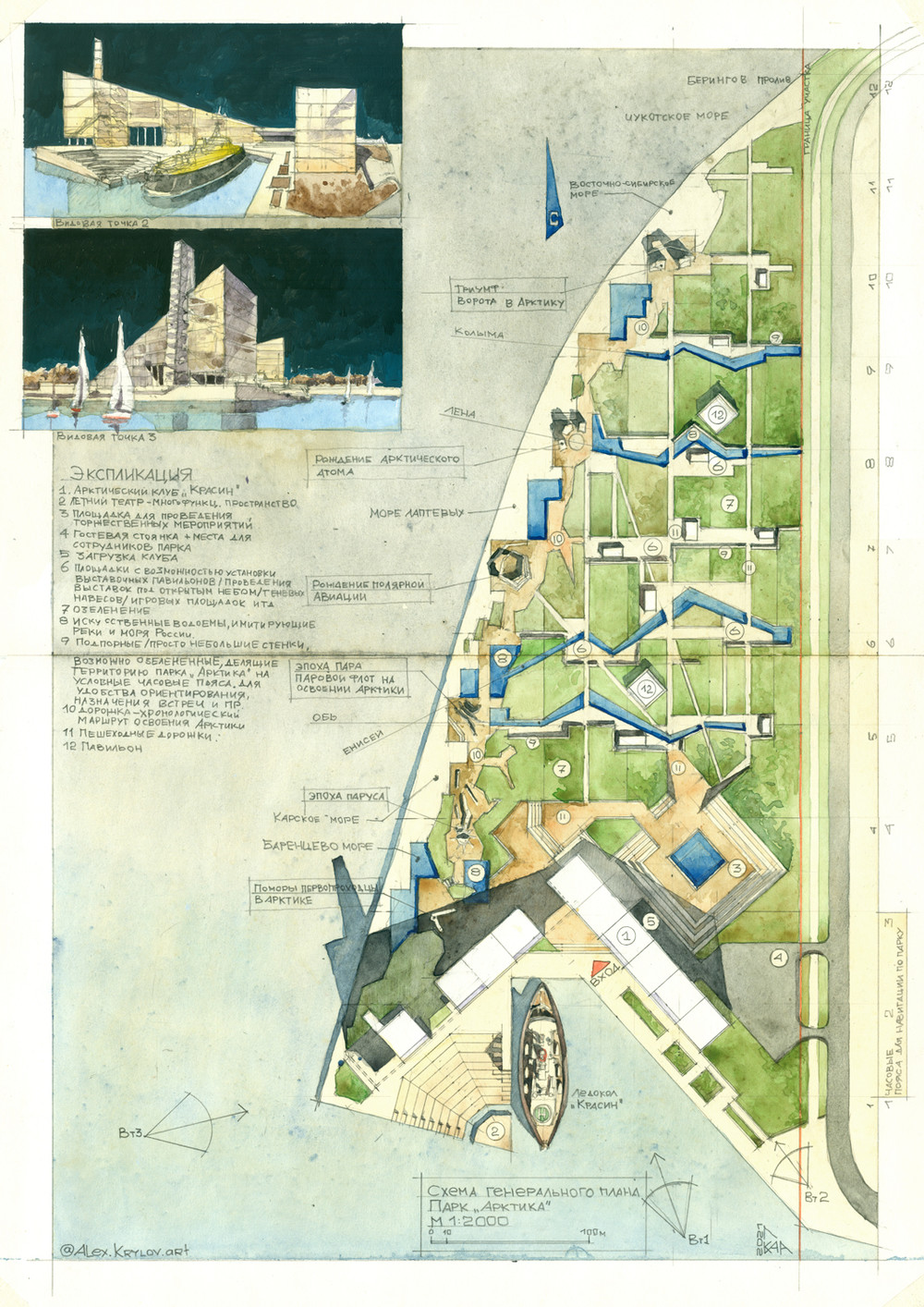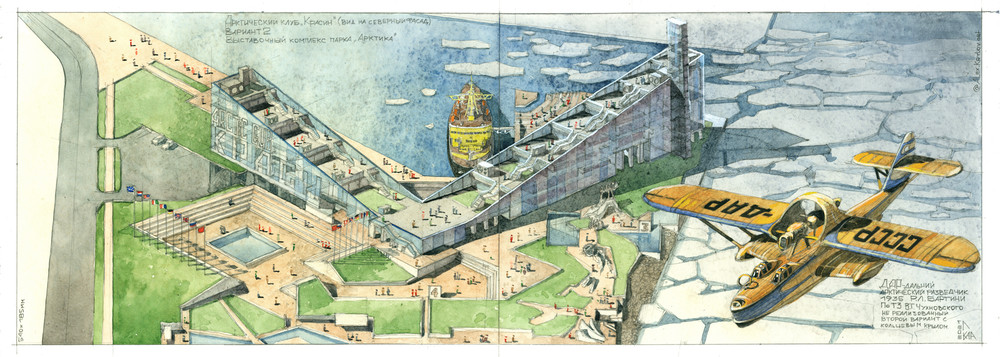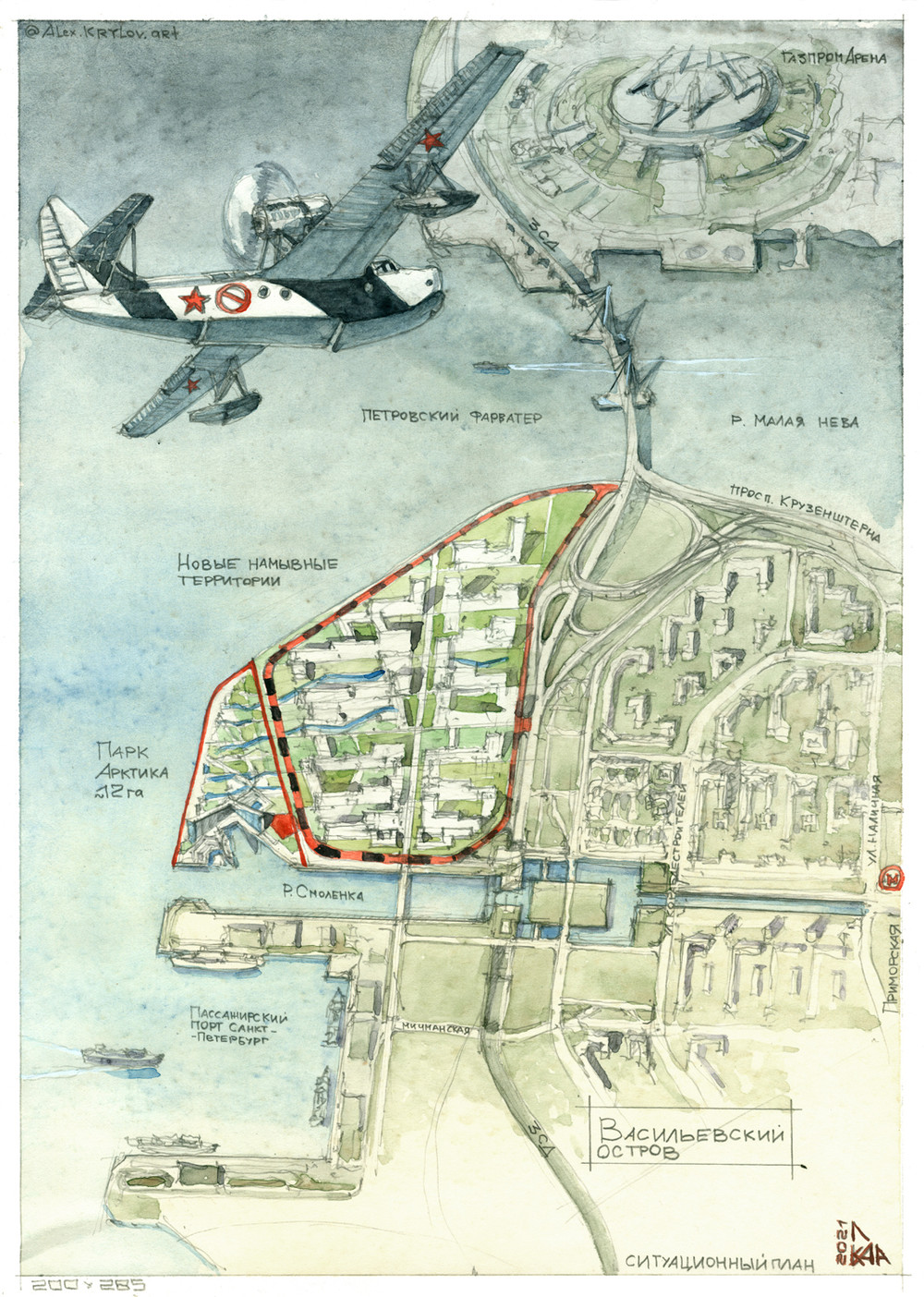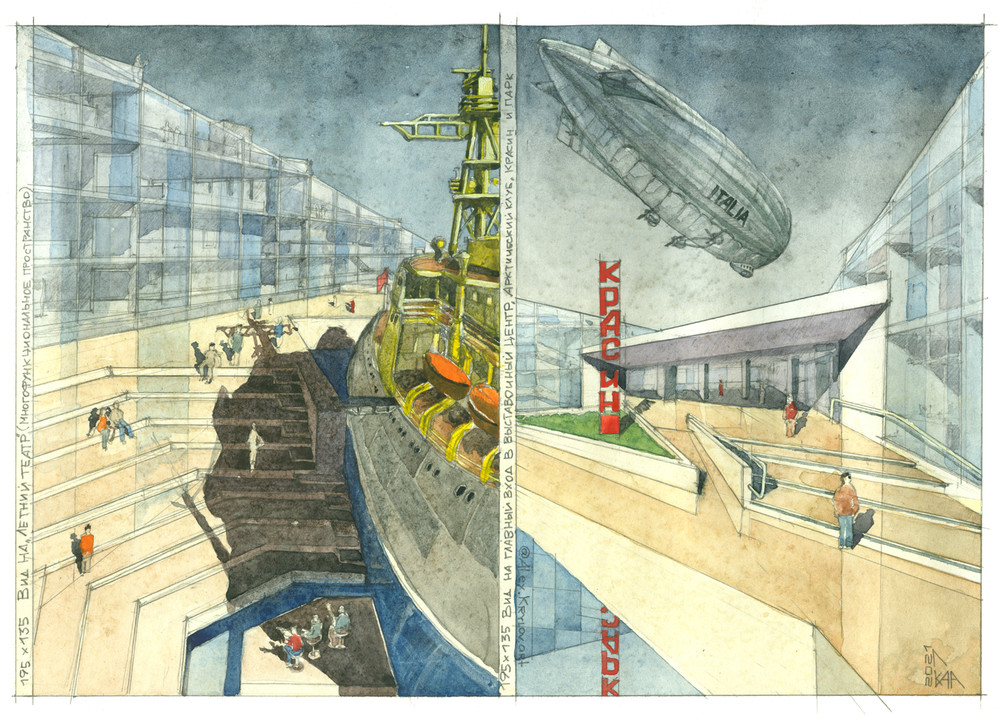«Рисунок-проект/Коллекция архитектуры»
Объявление участников выставки: до 25 апреля 2024 года


Krylov Aleksandr Крылов Александр/
- 55
- 6
-
2012 © www.archigraphics.ru.
Любое использование материалов сайта запрещено без согласования с администрацией сайта.
Техническая поддержка / Support
Author: Aleksandr Krylov
Работа выполнена коллективом авторов: Платонов С. А., Серов В. А., Крылов А. А., Подшувейт О. В.
Архитектурно-ландшафтная часть тематического парка «Арктика»
Данная концепция демонстрирует широкие возможности популяризации науки и истории освоения Арктических широт России.
Концепция служит основой для выработки технического задания всеми заинтересованными лицами с целью разработки конкретного проекта и дальнейшей реализации.
Расположение участка.
Участок парка расположен в городе Санкт-Петербург, на западной оконечности Васильевского острова на новых намывных территориях, недалеко от станции метро Приморская. С юга участок ограничен руслом реки Смоленка и пассажирским морским портом, с запада Финским заливом, с севера - Петровским фарватером реки Малая Нева, с востока- проездом нового жилого района.
Генеральный план тематического парка «Арктика».
Территория парка состоит из нескольких зон, связанных между собой. В южной его части находятся здание музея и общественного центра, образующие главный вход на территорию парка. Перед ним расположены: пешеходная набережная, искусственный залив образованный причальной стенкой, к которой пришвартован главный экспонат - ледокол «Красин» и летний театр. Далее, слева от музея, с юга на север, вдоль набережной, выходящей на Финский залив, располагается «историческая тропа», рассказывающая в хронологическом порядке историю покорения Арктических рубежей России. На ней устанавливаются скульптурные композиции, каждая из которых повествует об определенном периоде освоения Севера. Справа от музея расположена площадь со зрительскими рядами и флагштоками, в центре есть прямоугольный фонтан-бассейн, в котором можно проводить соревнования по судомодельному спорту или трансформировать бассейн в сцену. Остальную часть территории занимает парк с многочисленными площадками, на которых возможно расположение временной экспозиции под открытым небом, временных (сезонных) павильонов, теневых навесов, палаток с едой и сувенирами, игровых площадок с познавательными аттракционами и пр. Возможно проведение фестивалей и ярмарок.
Здание выставочного центра и Арктического клуба «Красин»
Выставочный комплекс представлен в виде двух объемов (большой музей и общественный центр меньшего размера), соединенных между собой навесом главного входа в парк и непосредственно входами в музей и общественный центр. Объемы корпусов выполнены в виде усеченных параллелепипедов, символизирующих ледяные торосы. Их наклон дает визуальное направление на вход в парк. Фасады функционально оттеняют главный экспонат музея - ледокол «Красин» и являться своего рода занавесом, отделяющим парк от городской среды. Фасады не имеют деталей, нарушающих целостность объемов. В нашем варианте фасады остеклены и имеют гравировку (название центра и чертеж разреза Ледокола), но могут быть и другие приемы (перфорированный, в виде вертикальных фигурных элементов, условно жалюзи, пилястры и пр.); главное, чтобы не нарушался монолит объемов. Передвижение посетителей (по коридорам, проходам, лестничным клеткам и в лифтах) внутри зданий осуществляется вдоль наружной остекленной оболочки фасадов. Таким образом, выставочные (в некоторых случаях двухсветные), лекционные и прочие объемы как бы подвешены во внутреннем пространстве и могут быть окрашены в разные цвета или иметь тематическую графику видную снаружи зданий.
С северной стороны корпуса музея находится смотровая башня-маяк, с расположенным внутри него лестнично-лифтовым узлом для подъема на самый верх площадки. С каждого этажа музея и общественного центра есть выход на эксплуатируемую кровлю, защищенную от ветра. Все кровли объединены общей наружной лестницей, по которой можно подняться с нижних ярусов на верхние.
Ландшафтные решения.
Территория парка выполнена в виде условной карты северных регионов России с искусственными водоемами, стилизованно имитирующими моря и реки нашей страны. Так же парк поделен на зоны, которые условно соответствуют часовым поясам. Это сделано для удобного ориентирования посетителей на территории и разделения парка на отдельные участки, которые можно использовать для проведения разных мероприятий. Все это осуществляется за счет архитектурных и ландшафтных решений, таких как подпорные стенки, ограждения небольшой высоты, озеленения, мощение и пр.
Лист 1. Вид на южный фасад.
Лист 2. Вид на северный фасад.
Лист 3. Схема генерального плана.
Лист 4. Ситуационный план.
Лист 5. Вид на летний театр и вход в парк.
The work was performed by a team of authors: Platonov S. A., Serov V. A., Krylov A. A., Podshuveit O. V.
Architectural and landscape part of the Arctic Theme Park
This concept demonstrates the wide possibilities of popularizing science and the history of the development of the Arctic latitudes of Russia.
The concept serves as the basis for the development of technical specifications by all interested parties in order to develop a specific project and further implementation.
The location of the plot.
The park site is located in the city of St. Petersburg, on the western tip of Vasilyevsky Island in the new alluvial territories, near the Primorskaya metro station. From the south, the site is bounded by the Smolenka riverbed and the passenger seaport, from the west by the Gulf of Finland, from the north by the Petrovsky Fairway of the Malaya Neva River, from the east by the passage of a new residential area.
The master plan of the Arctic Theme Park.
The territory of the park consists of several zones connected to each other. In its southern part there is a museum building and a community center, forming the main entrance to the park. In front of it there are: a pedestrian embankment, an artificial bay formed by a mooring wall, to which the main exhibit is moored - the icebreaker Krasin and the summer theater. Further, to the left of the museum, from south to north, along the embankment overlooking the Gulf of Finland, there is a "historical trail", telling in chronological order the story of the conquest of the Arctic borders of Russia. Sculptural compositions are installed on it, each of which tells about a certain period of development of the North. To the right of the museum there is a square with spectator rows and flagpoles, in the center there is a rectangular fountain-pool in which you can hold ship modeling competitions or transform the pool into a stage. The rest of the territory is occupied by a park with numerous sites where it is possible to place a temporary outdoor exhibition, temporary (seasonal) pavilions, shade canopies, tents with food and souvenirs, playgrounds with educational attractions, etc. Festivals and fairs are possible.
The building of the Exhibition center and the Krasin Arctic Club
The exhibition complex is presented in the form of two volumes (a large museum and a smaller community center), connected by a canopy at the main entrance to the park and directly by the entrances to the museum and community center. The volumes of the buildings are made in the form of truncated parallelepipeds, symbolizing ice hummocks. Their tilt gives a visual direction to the entrance to the park. The facades functionally shade the main exhibit of the museum - the icebreaker Krasin and serve as a kind of curtain separating the park from the urban environment. Facades do not have details that violate the integrity of the volumes. In our version, the facades are glazed and have an engraving (the name of the center and the drawing of the Icebreaker section), but there may be other techniques (perforated, in the form of vertical curly elements, conditionally blinds, pilasters, etc.); the main thing is that the monolith of volumes is not violated. The movement of visitors (along corridors, passageways, stairwells and in elevators) inside buildings is carried out along the outer glazed shell of the facades. Thus, exhibition (in some cases two-light), lecture and other volumes are suspended in the interior space and can be painted in different colors or have thematic graphics visible from the outside of buildings.
On the north side of the museum building there is an observation tower-lighthouse, with a staircase and elevator node located inside it to climb to the very top of the site. From each floor of the museum and the community center there is an exit to the exploited roof, protected from the wind. All roofs are connected by a common external staircase, which allows you to climb from the lower tiers to the upper ones.
Landscape solutions.
The territory of the park is made in the form of a conditional map of the northern regions of Russia with artificial reservoirs stylistically imitating the seas and rivers of our country. The park is also divided into zones that conditionally correspond to time zones. This is done to conveniently orient visitors to the territory and divide the park into separate sections that can be used for various events. All this is done through architectural and landscape solutions, such as retaining walls, fences of low height, landscaping, paving, etc.
Sheet 1. View of the southern facade.
Sheet 2. View of the northern facade.
Sheet 3. Outline of the master plan.
Sheet 4. Situational plan.
Sheet 5. View of the summer theater and the entrance to the park.
Размеры рисунка или рисунков (в см) / Sizes of the Drawing/Drawings (cm): 56x20 29x41 21х29
Drawing technique / Техника исполнения : Whatman, pencil, watercolor, tempera / Ватман, карандаш, акварель, темпера
Год исполнения / Year of the Drawing: 2021



